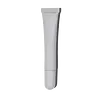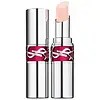What's inside
What's inside
 Key Ingredients
Key Ingredients

 Benefits
Benefits

 Concerns
Concerns

 Ingredients Side-by-side
Ingredients Side-by-side

Hydrogenated Polyisobutene
EmollientDiisostearyl Malate
EmollientButyrospermum Parkii Butter
Skin ConditioningPolybutene
Microcrystalline Wax
Emulsion StabilisingSynthetic Wax
AbrasiveOctyldodecanol
EmollientHydrogenated Poly(C6-14 Olefin)
EmollientPolyglyceryl-2 Triisostearate
EmulsifyingPalmitoyl Tripeptide-1
Skin ConditioningPhytosteryl/Isostearyl/Cetyl/Stearyl/Behenyl Dimer Dilinoleate
Skin ConditioningDisteardimonium Hectorite
StabilisingEthylhexyl Palmitate
EmollientParfum
MaskingTocopheryl Acetate
AntioxidantTribehenin
EmollientStevioside
MaskingSynthetic Fluorphlogopite
Tetrahexyldecyl Ascorbate
AntioxidantTheobroma Grandiflorum Seed Butter
Skin ConditioningOrbignya Oleifera Seed Oil
EmollientSorbitan Isostearate
EmulsifyingLactic Acid
BufferingTocopherol
AntioxidantCitric Acid
BufferingGeraniol
PerfumingHydrogenated Polyisobutene, Diisostearyl Malate, Butyrospermum Parkii Butter, Polybutene, Microcrystalline Wax, Synthetic Wax, Octyldodecanol, Hydrogenated Poly(C6-14 Olefin), Polyglyceryl-2 Triisostearate, Palmitoyl Tripeptide-1, Phytosteryl/Isostearyl/Cetyl/Stearyl/Behenyl Dimer Dilinoleate, Disteardimonium Hectorite, Ethylhexyl Palmitate, Parfum, Tocopheryl Acetate, Tribehenin, Stevioside, Synthetic Fluorphlogopite, Tetrahexyldecyl Ascorbate, Theobroma Grandiflorum Seed Butter, Orbignya Oleifera Seed Oil, Sorbitan Isostearate, Lactic Acid, Tocopherol, Citric Acid, Geraniol
Diisostearyl Malate
EmollientBis-Behenyl/Isostearyl/Phytosteryl Dimer Dilinoleyl Dimer Dilinoleate
EmollientPentaerythrityl Adipate/Caprate/Caprylate/Heptanoate
EmollientVp/Hexadecene Copolymer
Paraffin
PerfumingOctyldodecanol
EmollientCera Microcristallina
Emulsion StabilisingCI 45410
Cosmetic ColorantSorbitan Sesquioleate
EmulsifyingSynthetic Wax
AbrasiveAlumina
AbrasiveDisteardimonium Hectorite
StabilisingCI 15985
Cosmetic ColorantTocopheryl Acetate
AntioxidantEthylene/Propylene Copolymer
AbrasivePropylene Carbonate
SolventParfum
MaskingDextrin Palmitate
EmulsifyingTocopherol
AntioxidantMangifera Indica Seed Oil
EmollientSodium Hyaluronate
HumectantCaprylic/Capric Triglyceride
MaskingWater
Skin Conditioning1,2-Hexanediol
Skin ConditioningMangifera Indica Fruit Extract
Skin ConditioningPunica Granatum Fruit Extract
AntioxidantDiisostearyl Malate, Bis-Behenyl/Isostearyl/Phytosteryl Dimer Dilinoleyl Dimer Dilinoleate, Pentaerythrityl Adipate/Caprate/Caprylate/Heptanoate, Vp/Hexadecene Copolymer, Paraffin, Octyldodecanol, Cera Microcristallina, CI 45410, Sorbitan Sesquioleate, Synthetic Wax, Alumina, Disteardimonium Hectorite, CI 15985, Tocopheryl Acetate, Ethylene/Propylene Copolymer, Propylene Carbonate, Parfum, Dextrin Palmitate, Tocopherol, Mangifera Indica Seed Oil, Sodium Hyaluronate, Caprylic/Capric Triglyceride, Water, 1,2-Hexanediol, Mangifera Indica Fruit Extract, Punica Granatum Fruit Extract
 Reviews
Reviews

Ingredients Explained
These ingredients are found in both products.
Ingredients higher up in an ingredient list are typically present in a larger amount.
Diisostearyl Malate is an emollient and most often used in lip products. It comes from isostearyl alcohol, a fatty acid, and malic acid, an AHA.
As an emollient, Diisostearyl Malate helps create a thin film on your skin to trap moisture in. This helps keep your skin soft and smooth.
Disteardimonium Hectorite comes from the clay mineral named hectorite. It is used to add thickness to a product.
It can also help stabilize a product by helping to disperse other ingredients.
Hectorite is a rare, white clay mineral.
Learn more about Disteardimonium HectoriteOctyldodecanol is a fatty alcohol. It is primarily used to enhance the texture of products.
As an emulsifier, Octyldodecanol helps prevent the oils and waters from separating. It also prevents ingredients from creating foam when shaken.
Octyldodecanol is created by reducing fatty acid to an alcohol.
Due to its high molecular weight, it does not get absorbed into the skin.
Learn more about OctyldodecanolParfum is a catch-all term for an ingredient or more that is used to give a scent to products.
Also called "fragrance", this ingredient can be a blend of hundreds of chemicals or plant oils. This means every product with "fragrance" or "parfum" in the ingredients list is a different mixture.
For instance, Habanolide is a proprietary trade name for a specific aroma chemical. When used as a fragrance ingredient in cosmetics, most aroma chemicals fall under the broad labeling category of “FRAGRANCE” or “PARFUM” according to EU and US regulations.
The term 'parfum' or 'fragrance' is not regulated in many countries. In many cases, it is up to the brand to define this term.
For instance, many brands choose to label themselves as "fragrance-free" because they are not using synthetic fragrances. However, their products may still contain ingredients such as essential oils that are considered a fragrance by INCI standards.
One example is Calendula flower extract. Calendula is an essential oil that still imparts a scent or 'fragrance'.
Depending on the blend, the ingredients in the mixture can cause allergies and sensitivities on the skin. Some ingredients that are known EU allergens include linalool and citronellol.
Parfum can also be used to mask or cover an unpleasant scent.
The bottom line is: not all fragrances/parfum/ingredients are created equally. If you are worried about fragrances, we recommend taking a closer look at an ingredient. And of course, we always recommend speaking with a professional.
Learn more about ParfumSynthetic Wax is created from fossil fuels such as natural gas. It is used to enhance texture, adjust pH, and as an occlusive.
It may also be used as an abrasive ingredient to exfoliate the skin.
Synthetic Wax may not be fungal acne safe.
Learn more about Synthetic WaxTocopherol (also known as Vitamin E) is a common antioxidant used to help protect the skin from free-radicals and strengthen the skin barrier. It's also fat soluble - this means our skin is great at absorbing it.
Vitamin E also helps keep your natural skin lipids healthy. Your lipid skin barrier naturally consists of lipids, ceramides, and fatty acids. Vitamin E offers extra protection for your skin’s lipid barrier, keeping your skin healthy and nourished.
Another benefit is a bit of UV protection. Vitamin E helps reduce the damage caused by UVB rays. (It should not replace your sunscreen). Combining it with Vitamin C can decrease sunburned cells and hyperpigmentation after UV exposure.
You might have noticed Vitamin E + C often paired together. This is because it is great at stabilizing Vitamin C. Using the two together helps increase the effectiveness of both ingredients.
There are often claims that Vitamin E can reduce/prevent scarring, but these claims haven't been confirmed by scientific research.
Learn more about TocopherolTocopheryl Acetate is AKA Vitamin E. It is an antioxidant and protects your skin from free radicals. Free radicals damage the skin by breaking down collagen.
One study found using Tocopheryl Acetate with Vitamin C decreased the number of sunburned cells.
Tocopheryl Acetate is commonly found in both skincare and dietary supplements.
Learn more about Tocopheryl Acetate